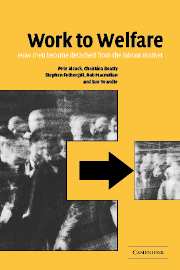Book contents
- Frontmatter
- Contents
- List of figures
- List of tables
- Notes on the authors
- Preface
- List of abbreviations
- Part I The context for labour market detachment
- Part II New evidence from the UK
- 4 The detached male workforce
- 5 Incapacity Benefit and unemployment
- 6 The over 50s
- 7 Family, life course and labour market detachment
- 8 The role of health in labour market detachment
- 9 Getting by
- 10 Back to work?
- Part III The policy implications
- Appendix: Research methodology
- References
- Index
10 - Back to work?
Published online by Cambridge University Press: 22 September 2009
- Frontmatter
- Contents
- List of figures
- List of tables
- Notes on the authors
- Preface
- List of abbreviations
- Part I The context for labour market detachment
- Part II New evidence from the UK
- 4 The detached male workforce
- 5 Incapacity Benefit and unemployment
- 6 The over 50s
- 7 Family, life course and labour market detachment
- 8 The role of health in labour market detachment
- 9 Getting by
- 10 Back to work?
- Part III The policy implications
- Appendix: Research methodology
- References
- Index
Summary
The preceding chapters mainly explored how men have become detached from employment. However, as chs. 2 and 3 explained, re-attaching the unemployed and inactive to the labour market has become a key preoccupation of governments in the UK and elsewhere. Indeed, it is often now the guiding principle in restructuring social security systems away from an essentially ‘passive’ model, geared to individual need, towards an ‘active’ model aimed ultimately at moving claimants off welfare altogether.
This chapter examines how non-employed men assess their labour market position and the possibility of returning to work. It does so primarily by drawing again on the in-depth interviews that were the basis of chs. 7, 8 and 9. The chapter concentrates on two groups of men: the long-term unemployed and the long-term sick. In the UK context these groups mainly comprise the men in receipt of JSA and IB, though the overlap between how men describe themselves and the benefits they are actually claiming is not perfect, as ch. 4 showed. These two groups make up about two-thirds of the ‘detached male workforce’, as we have defined it in this book, and the long-term sick are particularly numerous. As ch. 4 also showed, nearly 90 per cent of the long-term unemployed and around half the long-term sick say they would like a full-time job. Far fewer of the early retired – the other large group among the detached male workforce – express an interest in returning to work.
- Type
- Chapter
- Information
- Work to WelfareHow Men Become Detached from the Labour Market, pp. 228 - 248Publisher: Cambridge University PressPrint publication year: 2003

